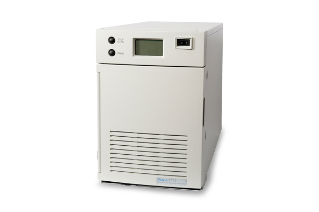Purification Solvent Management
Flexible and scalable modular pumps
As your lab’s productivity demands increase, so do your expectations for reliability, performance, and flexibility of your solvent delivery system.
Waters innovative preparative pump technologies provide extraordinary performance and convenience for benchtop purification of microgram to multigram sample loads. The full range of Binary and Quaternary Gradient Modules have been designed to meet all your purification needs.
Overview
- Easily configurable modules for a variety of purification protocols covering a wide range of sample matrices
- Exceptional flow rates provide you with the precision and accuracy you require
- Chromatographic reproducibility that you need to fully automate all your laboratory’s processes
- Exceptional solvent blending, automated solvent management, and pulse-free delivery, to meet even your most sensitive application challenges
Recommended Use: For flexible solvent delivery, whether for isocratic or gradient, or analytical or preparative.
Features Header
2545 Binary Gradient Module
The 2545 Binary Gradient Module (BGM) is a high-pressure mixing binary gradient pump that serves as the primary solvent delivery device for the LC Prep AutoPurification System, enabling subsequent isolation and purification of targeted compounds.
Features:
- Operates at analytical and preparative scales
- Performs between flow rates of 0.50 to 150.00 mL/min with a pressure up to 6000 psi
- Integrates solvent selection valves on each solvent delivery channel to allow for rapid solvent changeovers and system purges
- Streamlines the purification process via MassLynx Software control using FractionLynx Application Manager
2535, 2545, and 2555 Quaternary Gradient Modules
The 2535, 2545, and 2555 Quaternary Gradient Modules (QGMs) are four solvent, low-pressure mixing gradient pumps that serve as solvent delivery devices for purification systems. Dual programmable flow paths enable the system volumes to change when the column size is changed.
2535 QGM
- 50 mL/min capability for using columns up to 30 mm I.D. for purification of milligrams of material
- High pressure operation at 6,000 psi (414 bar) to accommodate a wide variety of column lengths, diameters, and particle sizes
2545 QGM
- 150 mL/min capability for using columns up to 50 mm I.D. for purification of milligrams to grams of material
- High pressure operation at 6,000 psi (414 bar) up to 100 mL/min with a roll off to 5,000 psi (345 bar) at 150 mL/min to accommodate a wide variety of column lengths, diameters, and particle sizes
2555 QGM
- 300 mL/min capability for using columns up to 75 mm I.D. for grams of material
- High pressure operation of 3000 psi (207 bar) at 200 mL/min with a roll off to 2,500 psi (172 bar) at 300 mL/min to accommodate a wide variety of column lengths, diameters, and particle sizes
QGM Features:
- Four-solvent gradient selection
- Two fluidic pathways (small scale and large scale) to accommodate column selection and chromatographic efficiency
- Control from MassLynx or Empower software or console, allowing scale up via a familiar software interface
- Interfaces to a variety of detectors and peak fraction collectors for optimum purifications
- Allows UV- or MS-directed purification with MassLynx Software
- Leak detection is standard
1525EF HPLC Pump
The 1525EF HPLC Pump is a high-pressure mixing binary gradient pump that is utilized in many semi-preparative configurations. It provides you with precision and accuracy, delivering the chromatographic reproducibility your lab requires.
Features:
- 225 μL pump heads deliver up to 22.5 mL/min
- Optional FlexInject Manual Dual Injector Module for both analytical and semi-preparative injections
- For semi-preparative applications: 10 to 30 mm inner diameter (I.D.) column separations
- Maximum operating pressure: 6000 psi up to 22.5 mL/min
Prep Degasser
The standalone, two-channel Prep Degasser helps optimize laboratory uptime and productivity through Helium sparging, which eliminates the need to degas mobile phases.
Features:
- Can be used in combination with low-pressure mixing solvent delivery systems (2535 QGM and 1525EF pumps) for runs of 45 mL/min or less
- Flow path materials and vacuum chambers are compatible with organic mobile phases vapors, for use with both reversed and normal phase chromatography
